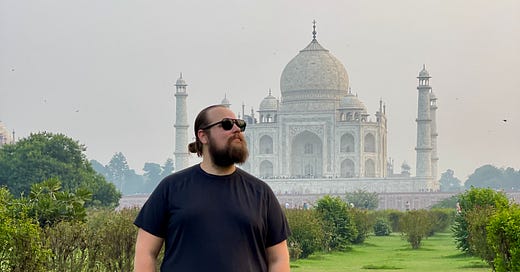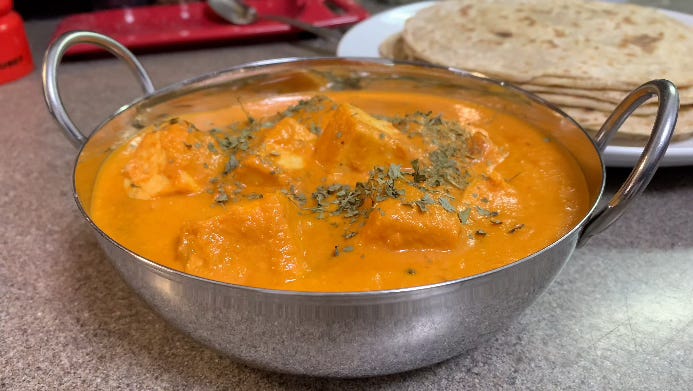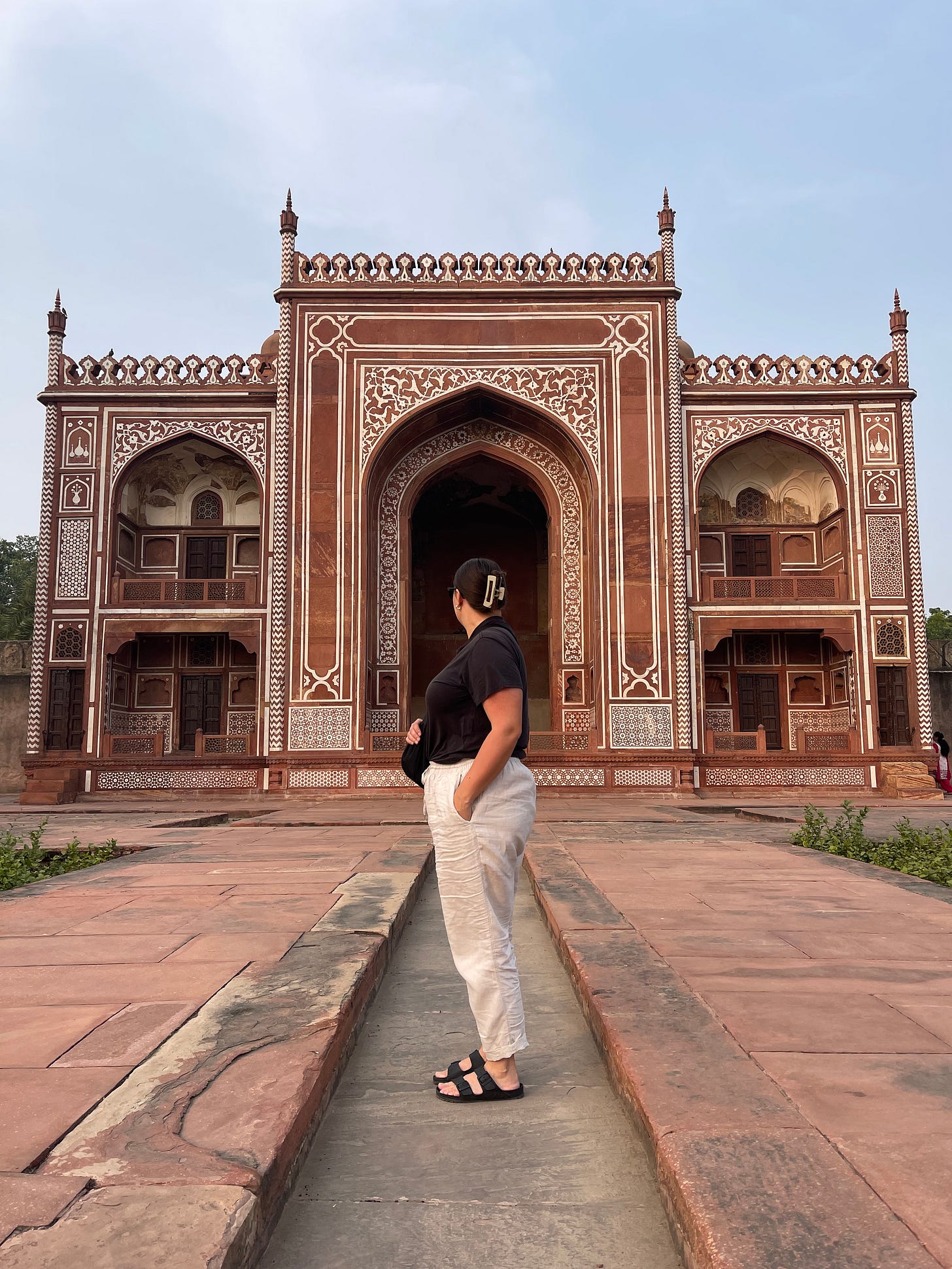As our last day in Jaipur arrived, we felt a familiar feeling of bittersweet excitement.
We really enjoyed our time in Rajasthan and we actually wished we could have carved out a few extra days to stay longer. But with that said, our accommodation wasn't exactly the Four Seasons and we were quite relieved to be moving to a new living space.
Our next stop, the city of Agra in the Northern Indian state of Uttar Pradesh. Home to one of the Seven Wonders of the World!
Seeing the Taj Mahal has been on our bucket list for a very long time (as is the case with the majority of travel enthusiasts)
Because of its fame and designation as one of the world’s most revered sites, the Taj Mahal attracts an average of 8 million visitors per year.
While the structure is undoubtedly iconic, the origin story of its construction is what really makes this one of the most spectacular architectural achievements the world has ever seen!
Shah Jahan, who was the fifth ruler of the Mughal Empire, was consumed by grief after the death of his beloved wife, Mumtaz Mahal.
He wanted to build her a tomb so magnificent that it could immortalize the immense love he had for her. This became the central purpose of the remainder of his life.
The Taj Mahal was completed in 1648 after a 17-year construction process involving 20,000 workers and 1,000 elephants to carry the heavy materials.
THIS is the real reason why the Taj Mahal is a Wonder of the World.
In a vacuum, it would still be an incredibly impressive showcase of Islamic, Persian, Indian, and Ottoman architectural fusion that has stood the test of time.
However, it is so much more than that. The Taj Mahal is a memorial to eternal love. It is beautiful and tragic all at once.
Shah Jahan was absolutely inconsolable after his wife’s death, and he poured everything that remained of his heart and soul into the creation of this mausoleum.
To bring this powerful love story full circle, Shah Jahan himself was eventually laid to rest inside the tomb beside his wife.
I have to admit that I did not know about this incredibly moving backstory until we had already arrived in Agra. It was a perspective-shifting moment to discover the real reason behind the Taj Mahal’s mystique!
I had occasional intrusive thoughts before arriving such as “are we falling into a tourist trap here” or “is it going to be able to live up to the hype” or even “there’s really no way it can top the Grand Mosque in Abu Dhabi”
I am very glad that we did our research, because I am not sure I would have enjoyed the experience as much otherwise.
Agra is an extremely historic place full of awe-inspiring architecture and three UNESCO World Heritage Sites. It is considered the “jewel box” of Northern India because of the many stunning relics left behind by the Mughal Empire.
At the same time, Agra is also a chaotic city plagued by extreme poverty and pollution.
It can be a difficult place to visit as a Western tourist because of how much we stand out just based on our appearance. There were definitely times where we felt like easy targets for scam artists and beggars.
With that said, we experienced remarkable hospitality from our hosts which ended up being one of the highlights of our time in India!
Our homestay helped us pre-arrange transportation for all of our sightseeing so we didn’t ever have to worry about getting lost.
To make it even better, they also cooked us traditional Northern Indian meals every single day!
Indian cuisine is something that Sidney and I have obsessed over long before we actually decided to visit India.
The first time we had an authentic experience with Indian food was when we lived in Chicago. There is a place on the north side called “Tandoor Char House” that has a fabulous lamb biryani!
After that, we found a handful of spots around the city that opened a whole new world of possibilities to our taste buds.
Fast forward to 2022 when we discovered that seemingly every European city offers a wide selection of authentic Indian restaurants! We would almost always have Indian on nights when we needed a little break from showcasing the local cuisine for our YouTube channel.
I tell you all of this to provide proper context to how life-changing it was for Sidney and I to have HOME-COOKED Indian meals for an entire week!
I would say it is hard to get more authentic than that!
One of my personal favorites was shahi paneer, a traditional Mughlai dish consisting of soft cheese in a spicy gravy with yogurt, onions, and nuts served with fresh chapati bread. The flavors were so well-crafted and I was impressed with the spice level.
I had actually never tried paneer despite seeing it on many Indian menus. This cheese is often used as a meat substitute since vegetarian diets are so common in India.
I mentioned in the Mumbai newsletter how I was shocked by how little I missed meat while enjoying the predominantly vegetarian cuisine. With that said, I was very excited when our hosts made us chicken angara on our last night.
This is a spicy chicken curry dish that is very popular in the northern region. The key ingredient is freshly ground masala powder. The chicken was char-grilled, and the gravy had a tantalizing deep red color!
The cook noticed how much we were enjoying the food, and he talked to us quite a bit on the last few nights.
It is so funny how clichés can sometimes be eerily accurate, but it is a small world after all! After I told him I was from Wisconsin, his eyes filled with excitement. It turns out that his son has lived in Madison for 5 years!
Here we were, on the other side of the planet from our family and friends in one of the most unfamiliar atmospheres we have ever encountered. And yet, we still managed to find a Wisconsin connection 😁
While the Taj Mahal was certainly the main event, we were also blown away by the other architectural highlights of Agra.
This included the Itmad ud-Daulah (which many tourists refer to as the Baby Taj) and the Tomb of Akbar.
Similar to the Taj Mahal, these structures are prime examples of Mughal architecture. The telltale features of this style are the bulb domes on top of the buildings, the pointed archways, and the intricate patterns along the edges of the walls.
Because of its roots in Islamic tradition, Mughal design is very common in Northern India, Afghanistan, Pakistan, and Bangladesh. However, Agra is considered one of the epicenters of this influence.
Although our time in Agra did not come without challenges, it was a fascinating experience and something we will cherish for a very long time!
Our final stop on an unforgettable maiden voyage in India was the southern mega-city of Bengaluru (formerly known as Bangalore).
This is the capital of the state of Karnataka and is considered to be the Silicon Valley of India.
This tech powerhouse has attracted startups and innovators from all over South Asia for the past few decades.
One of our first impressions was how different the climate was from Uttar Pradesh! Although it was only a 2 and a half hour flight from Agra, we had suddenly teleported into a jungle setting!
Although Mumbai also had features of a tropical rainforest climate, Bengaluru is significantly more south and, therefore, closer to the equator.
In Agra, we were in a mostly flat landscape about 350 miles south of the Himalayan Mountains.
It’s quite amazing how geographically diverse the country of India is, and because of that, we are definitely glad that we hopped around to several different states.
Another stark contrast we noticed from Agra is that Bengaluru, for lack of a better description, had a cool vibe!
Because of the younger demographic due to the tech industry, this city is absolutely teeming with nightlife! Bars were almost non-existent in Agra. In fact, we were advised not to walk around at night because the restaurants and markets generally start closing up at 10pm.
Bengaluru was a different story. Believe it or not, it is an awesome place to party!
Bars, microbreweries, and dance clubs can be found all over the city. And where there is alcohol, there is also likely to be street food!
It was really cool to see how the cuisine changed from region to region along with the landscapes. While we were in the northern states of Rajasthan and Uttar Pradesh, we were mostly eating stews and gravy-based dishes.
In Bengaluru, we came across dishes that were closer to what we experienced in Mumbai such as vada pav, bhaji, and dosa.
I’ve said it once and I will say it again.
Dosa is an INCREDIBLY delicious masterpiece and it may be the one thing we miss most about life in India.
Perfect buttery goodness. The crispiness of the pancake. Pure bliss!
Another interesting discovery we made about Bengaluru is that the common language is actually not Hindi! It is a language known as Kannada which has a completely different alphabet as well! WHAT???
I was definitely under the impression that the entire country spoke Hindi. It turns out that there are dozens of languages spoken across India. This absolutely blew our minds!
English is also widely spoken across the Indian subcontinent. We barely ran into any language barrier issues during our 18-day visit. British colonialism certainly played a part in this, but the main reason that present-day India speaks so much English is because it is used as the common language between all of the regions to communicate across language barriers within their own borders.
There is no way I could possibly summarize or paraphrase our entire experience, but I think one overarching takeaway is that we now have a much deeper understanding of how culturally diverse the country of India truly is.
Before our visit, I think we both imagined India as a single cultural entity. The truth is, every region, every state, even every city to some degree, has its own cultural identity.
The scale of India is quite overwhelming. It is a place that I don’t think we could ever discover or understand completely.
But I can say with absolute certainty that we would love to go back and see more if we ever get the chance!
We are very glad we powered through the nerves and took the leap into an unforgettable cultural experience!













